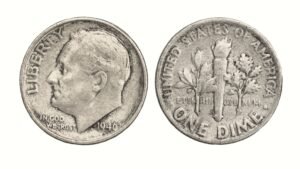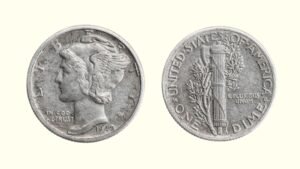Have you ever thought if an old dime could be worth up to $10,000? Sounds dreamy, right? But it really can if it’s the iconic 1967 Roosevelt Dime! From rare mint errors to pristine Special Mint Set examples, let’s understand how to spot a valuable 1967 dime and assess its market value!
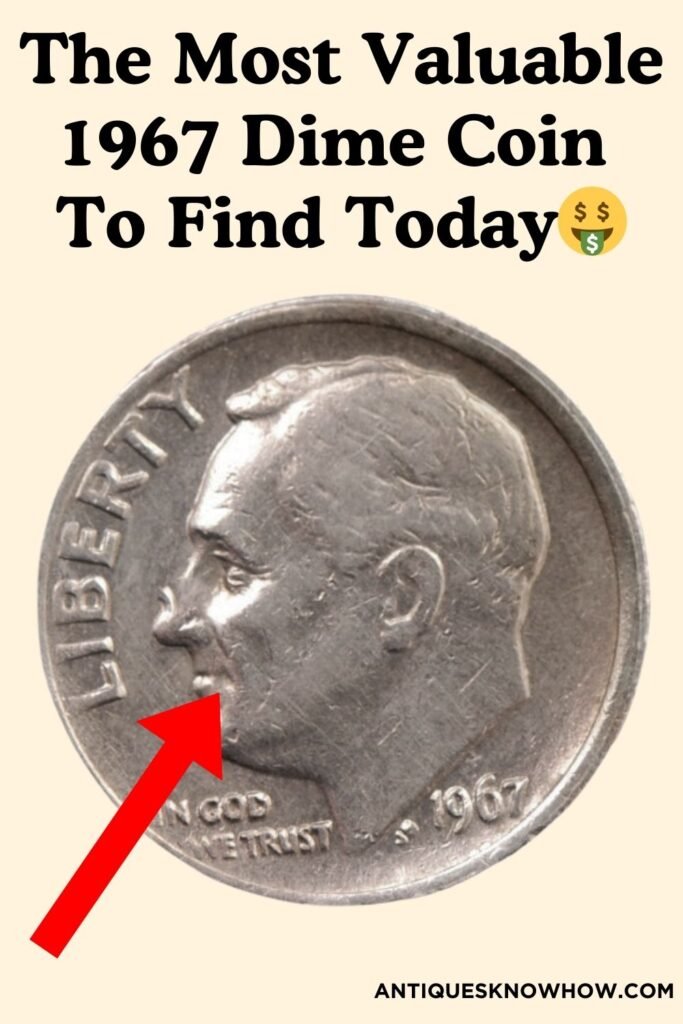
1967 Roosevelt Dime History
The 1967 Roosevelt dime is a part of the series first introduced in 1946 to honor President Franklin D. Roosevelt. The year continued dime production in the copper-nickel clad composition after the silver composition was stopped in 1965.
Besides, the 1967 dimes were minted only in Philadelphia, without a mint mark, as part of the government’s efforts to discourage coin collecting and increase circulation. Nonetheless, the rarity and special features, especially of the 1967 SMS coins, make them highly collectible today!
| 1967 Roosevelt Dime | Key Facts |
| Coin Composition | 91.67% copper, 8.33% nickel |
| Minting Location | Philadelphia, Denver, San Francisco |
| Year of Minting | 1967 |
| Weight | 2.268 g |
| Diameter | 17.91 mm (0.705 in) |
| Thickness | 1.35 mm (0.053 in) |
| Designer | John R. Sinnock |
| Face Value | $0.10 (10 cents) |
| Mint Marks | No Mint Marks |
| Total Mintage | 2,245,867,320 coins |
How to Identify a 1967 Dime Design & Composition
To appraise the value of the 1967 Roosevelt Dime rightly, it’s important to identify its design and composition. Here’s an overview of these features:
1967 Roosevelt Dime Obverse:
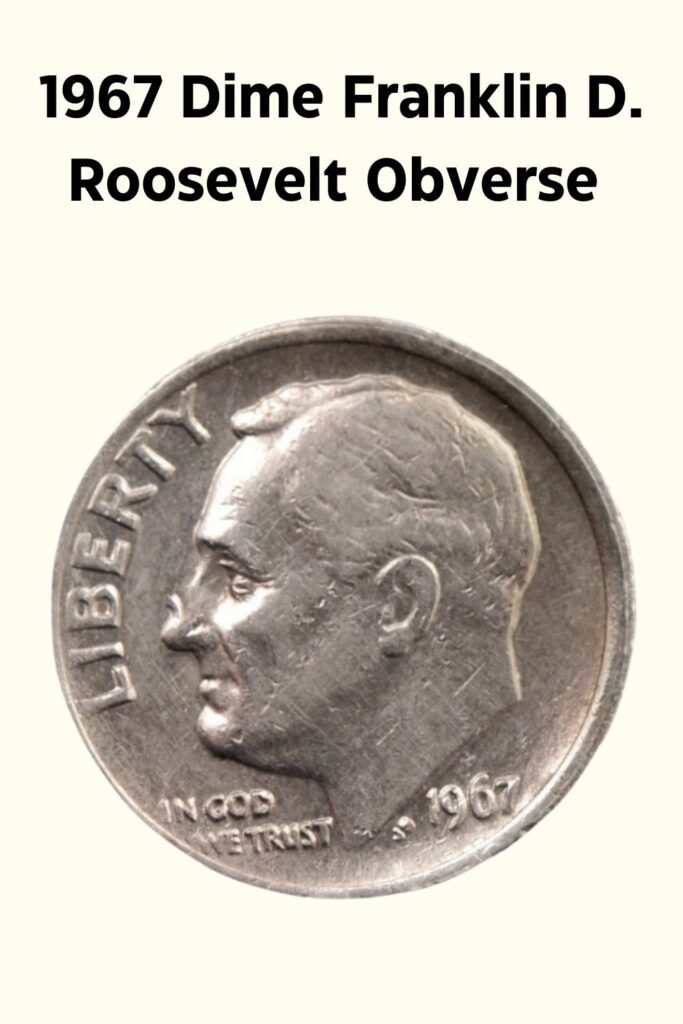
- A left-facing portrait of Franklin D Roosevelt
- The “IN GOD WE TRUST” motto to the left of Roosevelt
- The word “LIBERTY” along the left edge
- The mint date “1967” below Roosevelt’s neck
- The designer’s initials “JS” at the base of Roosevelt’s neck
1967 Roosevelt Dime Reverse:

- Torch in the center
- An olive branch to the left of the torch
- An oak branch to the right of the torch
- The words “UNITED STATES OF AMERICA” along the top edge
- The denomination “ONE DIME” below the torch
- “E PLURIBUS UNUM” motto to the right of the torch
Coin Composition & Dimensions
The 1967 Roosevelt Dime followed the new composition of an outer layer of 75% copper and 25% nickel bonded to a pure copper core, which gives it a total of 91.67% copper and 8.33% nickel.
Due to this changed composition, these coins weigh around 2.268 grams. As for the dimensions, it has a diameter of 17.91 mm or 0.705 inches and a thickness of 1.35 mm or 0.05 inches. Lastly, the 1967 dime has a reeded edge with 118 reeds!
Finding a 1967 Roosevelt Dime Value (5 Key Factors)
The value of a 1967 Roosevelt Dime in average or uncirculated condition ranges from $0.10 to $1.00. However, certain factors can significantly increase its value from a few hundred to a few thousand, including mint marks, condition, and minting errors.
Here’s how to assess each value factor in detail:
1. Coin Grading and Condition
Your 1967 Roosevelt Dime’s value is affected by its condition, which you can assess based on its wear, luster, and overall appearance. Professionally, coins are graded on a scale from Poor (P-0) to Mint State (MS-70), with higher grades meaning better condition.
An MS67 or higher grade 1967 dime can fetch up to $1,500 or more, while lower grade coins generally sell for around $1 to $10.
2. 1967 Roosevelt Dime Full Band Variety
The Full Bands designation (FB) Refers to the clarity and full separation of the bands on the torch on the reverse of the 1967 P Roosevelt Dime coin. These features can affect the coin’s value.
For example, a 1967 dime-graded MS68 FB once sold for $1,440 on Heritage Auctions. Lower-grade mint examples can also easily fetch $30 to $400, while circulated FB dimes, like regular coins, are worth only a few cents.
You can use the following 1967 Dime value chart to find the average value of your 10-cent coin based on grades.
| Coin Grades | Condition Details | 1967 No Mint Mark Dime Value | 1967 No Mint Mark Dime FB Value |
| Poor (0) to Extremely Fine (XF45) | Significant wear, faded but visible details | Face Value | Face Value |
| Almost Uncirculated (AU50) to Mint State (AU58) | Slight wear on highest points, visible marks or blemishes | 50 cents to $1 | 50 cents to $1 |
| Mint State (MS60 – MS64) | Uncirculated with minimal wear | $1 – $5 | $5 – $15 |
| Mint State (MS65 – MS66+) | Nearly flawless with very minor imperfections | $8 – $15 | $30 – $130 |
| Mint State (MS67 – MS67+) | Well-preserved with no major flaws | $10 – $50 | $150 – $350 |
| Mint State (MS68 or Above) | Nearly perfect, luster, no major marks or flaws | Around $55 | Up to $1,450 |
3. Mint Marks & Mintage
The mintage of a 1967 dime coin also directly impacts its value. With a total mintage of 2,245,867,320 coins, the 1967 Roosevelt Dimes are quite common.
Generally, the value of coins minted at different locations, i.e., Philadelphia, Denver, and San Francisco ranges. However, since all 1967 dimes were minted without mint marks at Philadelphia, the value of coins remains almost the same.
4. 1967 SMS Roosevelt Dime (Special Strike)
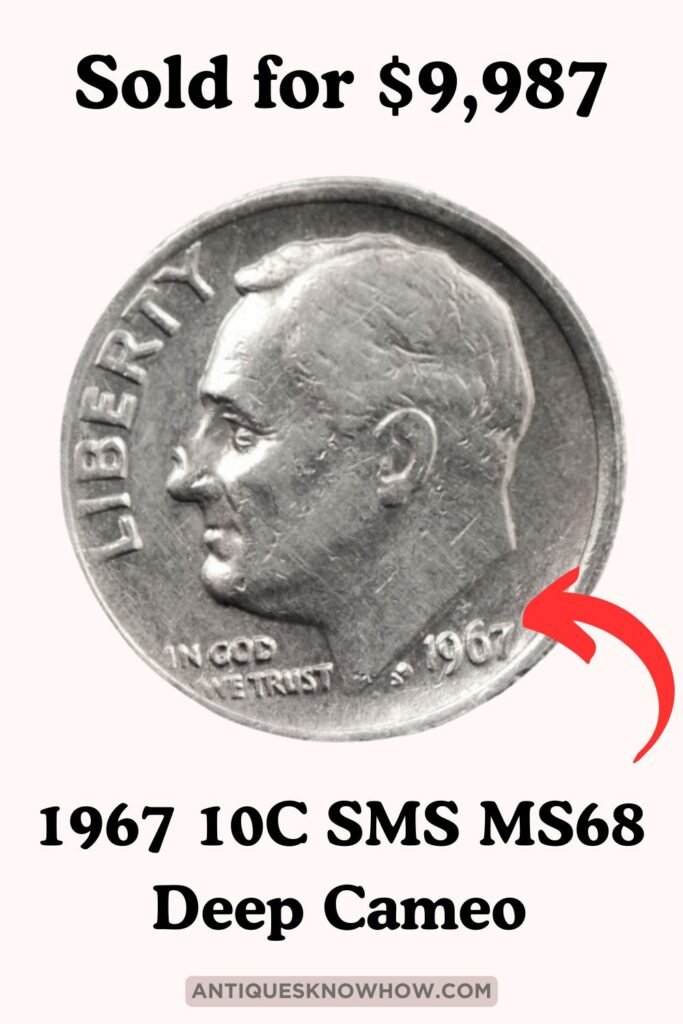
The United States Mint released around 1,860,000 Special Mint Set 1967 dimes for collectors at the Philadelphia Mint. These coins feature a higher-quality satin-like finish with sharp details and reflective surfaces, which make them more valuable than regular dimes.
Depending on the contrast between the design elements and surface, there are three types of 1967 SMS dimes:
- Regular SP (Special Strike): These 1967 SMS coins are the most common type, featuring a uniform, satin-like appearance without contrast between fields and devices. They are generally worth $15 for an SP67 to around $200-$300 for an SP69!
- Cameo (CAM) SMS Coins: Featuring a moderate contrast between frosted design elements and mirrored fields, Cameo SMS coins are more valuable. An SP65 Cameo might be worth $15-$25, while an SP67 Cameo could fetch $30-$50, and an SP69 could fetch up to $2,300!
- Deep Cameo (or Ultra Cameo) SMS Strike: With the strongest contrast between frosted designs and highly reflective fields, DCAM SMS coins are the rarest and most valuable. Values for Deep Cameo specimens can range from $250-$950 for an SP67 and $1,200 to $9,900 for an SP68. Higher grades can fetch even more.
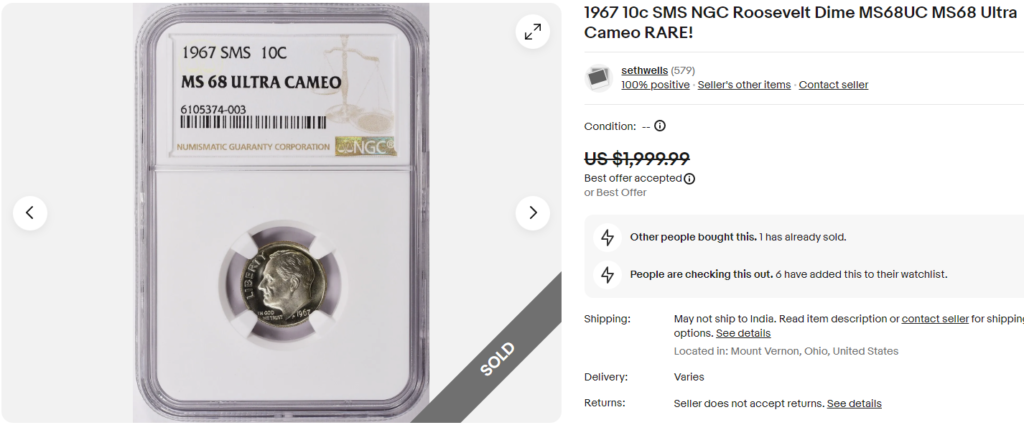
5. 1967 Roosevelt Dime Errors (List with Values)
Mint errors that occur during striking are rare and can significantly increase a 1967 dime’s value. Here are a few notable 1967 dime errors to look for:
Missing Clad Layer
This error occurs when a 1967 dime misses getting the outer layer of copper-nickel on the inner copper core. It can affect one or both sides of the coin. A fully exposed copper core on both sides is rarer and more valuable.
Values range from $50-$100 for a partial missing clad to $200-$500 for a complete missing clad, depending on the condition and extent of the error. For example, an AU58 1967 dime with a missing obverse clad layer sold for $144 on Heritage Auctions!
Doubled Die Obverse
Doubled die errors occur during the die manufacturing process, doubling the design elements on the die, which are then transferred to the coin during striking.
Although the 1967 Roosevelt Dime doesn’t have any major known doubled die varieties, minor doubling can occur. A DDO coin might range from $25 – $100, with more pronounced doubling fetching more.
Off-center Strike
Off-center strikes occur when the coin is misaligned during striking, causing a part of the design to be cut off. The estimated value of an off-center 1967 dime depends on how much of the design is missing and whether the date is visible.
A 5-10% off-center might be worth $20-$50. For instance, this coin with almost 80% of the design missing except the mint date sold for $28 on eBay. A 50% off-center with the “1967” date showing could fetch $100-$300 or more.
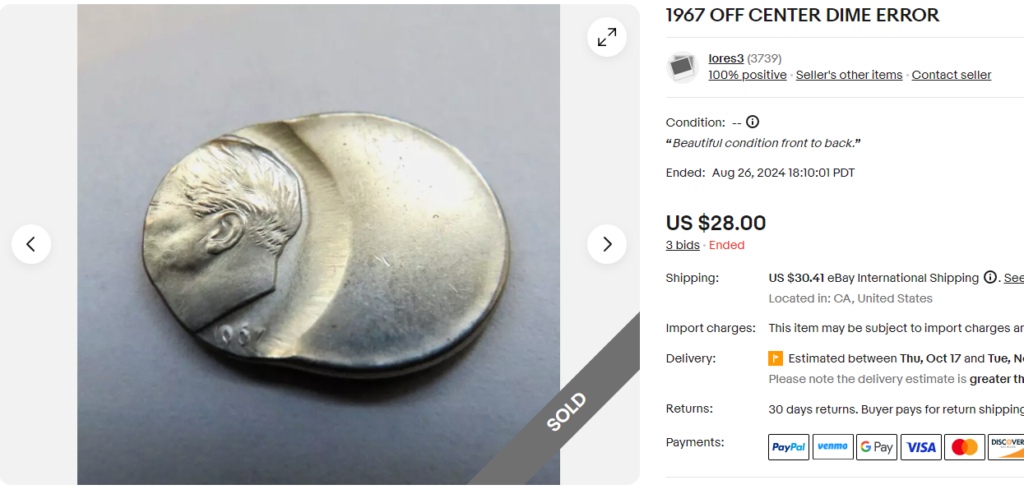
Apart from these, you also come across rare 1967 error dimes, such as broadstruck dimes or those with wrong planchet errors. These coins can also fetch premium prices, depending on the 1967 dime’s condition.
Remember, most 1967 Roosevelt dimes are worth 50 cents to a few dollars. Only the high-grade FB specimens, the Special Mint Set coins, and those with rare errors are worth a reasonable price. So, make sure to verify all these features before selling or buying a 1967 dime.
Note: This article is intended for informational, educational, and entertainment purposes only. Some images are illustrative and may not represent actual brands, products, or related entities. All trademarks, product names, brand logos, packaging, and other intellectual property referenced remain the exclusive property of their respective owners. Any brand mentions or references are provided solely for descriptive and educational context and do not imply any formal or commercial association.


